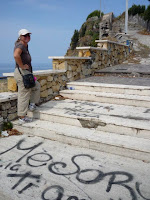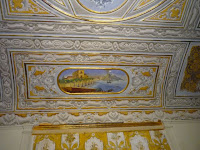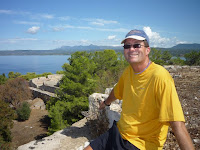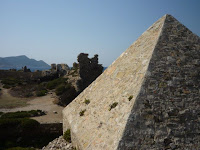It wasn’t until we were within a couple of miles of the island that we started having some real fun. I thought I started seeing a lot of foam on the water. I had assumed it was part of the general pollution problem, then I realized what it was: rocks! Pumice was floating in ribbons along the currents flowing past the island. Soon we had the fishing net out and were busily trying to catch the bigger pieces.


Some of the collected pumice stone, and the grander rock spires
We passed north of the island in the gap between Lipari and Volcano and immediately decided to detour to see a couple of tall rock spires jutting out of the water on the Lipari side of the channel with a backdrop of craggy inlets and natural arches ashore. From there we made a bee-line to the anchorage on Volcano at Porto Ponente. The anchorage was a lot more crowded than we anticipated. We quickly identified the party boat and anchored as far away as possible in the shallows by the black sand beach. The anchorage was beautiful; the volcanic rock had eroded away at the base leaving tall spires and steep mounds jutting into the sky. It looked more like the south Pacific or Indonesian than the Mediterranean (at least to one side of the harbour). The south side of the harbor was filled by the smoldering volcano. We enjoyed a dinner with a stunning and ever changing sunset before retiring for an early night. There was just enough residual cloud from the earlier storms to streak the sky with pink, oranges and reds as the sun dipped below the horizon.


A stunning anchorage sunset and a WAY TOO Early start to the next day
Much to Maryanne’s consternation we were up EARLY the next morning. In this case I mean morning purely in the academic sense as practically speaking it was still pitch-black night. I had a plan! We were going to climb the volcano at the first possible minute in the hopes of:
1) Beating the crowds
2) Being done with at least the climbing part before it became too hot.
We succeeded in both cases. We must have been the first people awake on the island when we landed the dinghy at the pier and the look on Maryanne’s face indicated that she still wasn’t fully on board with my plan. Good sport that she is she humored me and came along anyway {Maryanne: Only complaining every 30 seconds or so}. We stepped off the road and onto the steep trail just ahead of a solo climber coming from the other way on the same road. We almost ended up being the first people up – that one guy quickly passed us on the walk up as we stopped to admire the views and snap pictures. Another guy appeared out of nowhere once we reached the rim. The climb started out as a difficult one on lose gravel and ash (much like walking uphill in dry sand), but from about 1/3 of the way up the trail changed to bare clay and leveled compressed ash which made for much faster going. We arrived at the crater rim just as the rays from the rising sun were shining through the plumes of hydrogen-sulfide gas venting from many yellow-rimmed fumaroles. The views from their were spectacular (that word again), we could see the nearest four Aeolian islands as well as Footprint in our anchorage, the crater floor and the entire rim dotted with crusts of yellow sulfur.



First views from the crater
We had intended to take the rim route. The path to clockwise ran right through the heaviest of the smoke and was fronted by an official looking sign in Italian that we took to mean ‘go no further or die’. There was one section of the rim we would not be able to traverse. Now rather than circle the rim we took the path counter clockwise and there met the second guy on his way down from the highest point – he must have been on the mountain very early!
The further we climbed around to the high side of the rim the more beautiful the views became and my vocabulary seemed limited to “Wow” on a regular basis. On the far side at the highest point we could see the crater floor, the vents, Footprint in her anchorage and many of the other Aeolian islands, it was an amazing place to be. Not realizing it would be such a short hike we’d packed lunch and decided to break out our sandwiches and enjoy the view (who cares if it was still breakfast time). I spent some time idly exploring the landscape with the binoculars we’d carried and the site of the crust of sulphur made me decide that I had to continue and descend to get as close as I could to the vents, even though we had planned to just turn around and retrace our steps from the peak.
Maryanne stayed behind at the peak while I trekked down the scree slope as close as I dared to the exhausting gasses. I stayed for a while snapping as many pictures as I could and then started the climb back to the peak towards Maryanne. As I was making my way back up the switchbacks of this steep section of rim I looked back to notice that others had now arrived at the rim and the vents. They stopped at the warning sign as we did, and seemed to debate whether to go on or not (as we did) but then they just marched right through the field of fumes. I was expecting at any moment to hear screams of horror and see collapsed bodies, or at least coughing and gasping as they struggled back into clear air, but apart form a few slight detours to avoid the worst, they just marched on through. Not only that but they didn’t seem to be experienced hikers but a group of colorfully clothed German grannies, with not a back pack nor a bottle of water between them. I made it back up to Maryanne. I was actually still leaning towards backtracking our steps along the rim and missing the steaming section, but it was Maryanne who was showing clear signs of not wanting to miss out. She ended up convicting me {Maryanne: hardly hard!} to continue on through the venting fumes.




Close up to the sulfur vents
We descended back down towards the fumaroles (this time together) but this time armed with the courage (or foolishness) of having seen someone else do it first, we got much closer to the vents, staying up wind to avoid inhaling too many nasty fumes. They were beautiful up close. The white gas came spewing out of the earth at close to boiling kettle steam temperatures and we could watch as delicate yellow crystals formed around the rim of each vent, making each one look like a giant geode. The moment of truth had come, and we lingered for a while admiring the shapes, but eventually it came time to stop stalling we had to push on through our first plume of hydrogen-sulfide gas. I made a plan for where to put each footstep, waited for a thin stop in the cloud and charged on through. It was a lot more frightening than I expected. Firstly, when the smoke engulfs you, you can’t see your feet and so can’t tell where you are about to step, that’s quite disconcerting on the rim of a volcano. Secondly, even though the white smoke looks like steam, it is not, it is (very) slightly acidic and is uncomfortable to breath in, AND it is quite warm; It is not possible to stand there and breath it in while you figure out what to do, you HAVE to keep moving and hope you make it to the other side (which luckily for us was all of a 2 or 3 steps away).




So... this is perfectly safe right???
Maryanne came through behind me and being slightly, oh shall we say, lower to the ground (?) ended up taking a much larger blast in the face than I did. We both unanimously decided at that point that we would not be able to manage the basic route along the crater rim, but would detour just below the fumaroles on a ragged trail descending into the rim (the same trail the German grannies had taken). The landscape was extraordinary with smoke hissing out of the ground from large and small vents and occasionally enveloping us in a stinky haze of sulfur. We found whole boulders of pale yellow sulfur deposits as we made our way back to the rim starting point and the mystery Italian sign. At one point I noticed a strange sound. I reached down to the ground and rapped my knuckles on the rock – it returned a hollow ring – this part of the crater wall was just a think crust and we were scrambling along it. After that I found myself, mostly out of curiosity, tapping on the very ground we walked on like a climber looking for good ice.
Once we had finally completed our navigation of the ring there were perhaps a dozen other hikers who had reached the rim and were making their way along the trails. We were relieved to see that many were Italians and also chose to take the sulfur rim route even after reading the mystery sign – so we were not too crazy!
Yet another scraggly trail led to the crater floor, this time there were no signs but nobody was using so far that day. The crater appeared less obviously active than the sulfur section of the rim, so I decided to be the first for the day to descend to the floor of the crater. The start of the trail was steep and made of loose gravel and ash and in order to keep from sliding it was necessary to very carefully select each step, taking it slowly. Every time I slid and caught myself on my hands I kept thinking back to all of the warning signs we had seen at the trail entrance and one in particular that admonished us NOT to SIT on the ground due to ground layers of poisonous gasses. That kept me moving. The descent trail took me down via two intermediate shelves. Each time I stepped over the edge of a shelf, the trail was steep, loose and scary, gradually reducing to a slight descent on hard crust. Finally at the crater floor I was able to look up and see the entire north wall covered with yellow sulfur deposits and rising columns of gas. It was pretty cool.
With such an early start we found ourselves descending the mountain just as the bulk of the crowds began their ascent in the beginning of the day’s heat. Rather than head directly back to Footprint, we walked into the ferry terminal using the steady stream of walkers to find the source, and soon found ourselves at a comfortable table in Porto di Levante for the obligatory gelato and a beer as reward for our efforts (as if the view wasn’t enough!). We relaxed and watched several ferries disgorge their passengers of what appeared to be mostly day trippers who we then joined as they marched on the flat road across the narrow pinch of the island to the mud bath pool and beyond to the black sand beach of Porto Ponente where we rejoined Footprint for a refreshing swim and a lazy afternoon.


Rocky outcrops all over the island, and the popular mud-bath






































